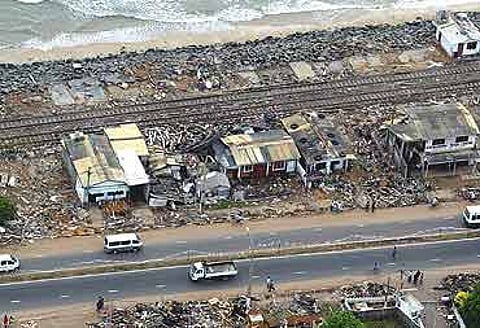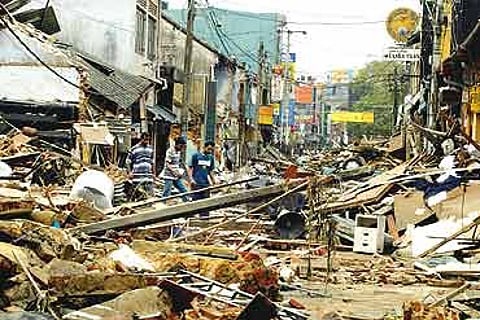"I knew at once it couldn’t have been a crocodile as such a large number of birds wouldn’t get simultaneously disturbed," she recalls. It was then that she turned to glance at the sea, just 150 metres away. The view was terrifying: giant tidal waves were sweeping towards the lodge. "Tidal wave, run, run," she shouted, rushing out of the lodge. Outside, she came across a child lying on his face. Hettige picked him up and began to run.
The Tear Drops
The Emerald Isle had always looked on the sea as a calm presence. One cruel Sunday, it betrayed them with a fury that decimated 25,000 or more.
At that point, she couldn’t understand anything; the sea’s inexplicable caprice in spilling over on to the beaches at an incredible speed; she didn’t even know it had a name: tsunami. All she knew, instinctively, was that she had to run away from the sea. Behind her, the sea was pouncing for its quarry. She then glimpsed a wall of water approach her from the left. It was now either her or the child. "I let go of the child," she laments. "I had to cling to a tree with both my hands."

The sheer ferocity of tidal waves tore her away from the tree. "It was like riding a motorcycle full clip." Without controls, at the mercy of the gushing waters. She was bashed against a giant cactus. From one place to another she was tossed around. "It seemed dozens of men were forcing me to remain under water. Each time I went down, I had the presence of mind to hold my breath," she recalls.
Smashed against a tree, Hettige was swept into the Yala National Park precincts. Miraculously, she got entangled in a milla tree. Her body ached; her mind was blank. And then yet another tidal wave, cleaner and clearer than before, swept across the park as she pressed against the tree with all her might. "The force of the water was astonishing. I couldn’t keep my fingers closed. My wedding ring was yanked out."
As the angry ocean, propelled by a temblor, retreated, Hettige wended her way to the lodge, battered and bruised—and perhaps scarred forever. But at least she’s alive, unlike many others who had gone into the Yala National Park that day to relish the beauty of nature. Park officials say there were 150 vehicles inside the park at the time the first of the tsunami waves smashed the coastline; only 50 of these have returned. About 250 visitors, including 17 Japanese and several European guests, remain missing.

The dead at Yala National Park comprise an infinitesimal fraction of Wednesday’s staggering death toll of 25,000 in all of Sri Lanka; not counting the estimated two million displaced. The casualty figures will continue to get revised as rescue and relief teams reach inaccessible areas.
Of the 25,000 dead, nearly 18,000 have been reported by the LTTE from the area it controls in the north. The rebels say hundreds of villages have been washed away, thousands have been rendered homeless and destitute. They say women and children constituted the bulk of the victims, unable as they were to run away from the fury of the sea. Indeed, statistics have acquired a new meaning as those alive count the dead. For instance, the Inter University Students Federation says some 500 students living along Sri Lanka’s coast are still missing; over 70 foreign tourists, says the government, have yet to be accounted for.

It seemed the sea consciously sought out those who drew sustenance from it, or those who found on its beaches their few days of paradise, to display its unseen, cruel, dark self. Take the Samudradevi (Queen of the Sea) train; it was crammed with holiday-makers as it pulled out of Colombo at 7 am. On board were an estimated 1,700 passengers, most of whom were headed to Galle. At Seenigama, the last town before Galle, a moving wall of water lifted the train off the track and flung the coaches around. Nobody survived to tell the story about the horror.
Two popular holiday resorts—the Yala Safari Beach Hotel and the Nilaveli Hotel, situated on Sri Lanka’s scenic eastern coast Trincomalee—have been completely destroyed. In addition, 19 other hotels on the coast have suffered extensive damage. Foreign tourists who had winged away from their cold climes to enjoy Sri Lanka’s sun and sands had, in the few seconds of the tsunami lashing the country, their ideas of happiness turned inside out. Idyllic beaches turned into watery graves as the ocean sucked into its rumbling belly companions and partners. The Tapias from France, holidaying in the southern town of Koggola, were luckier than most. As the angry waters swirled around them, Christopher twice dived into the sea to pull out his wife Francois and daughter Stephani. His other daughter Florence recalls, "My mother was unconscious when my father brought her up, and then had to dive right back to save my sister’s life. I gave them mouth-to-mouth resuscitation." The family then swam to safety and sought refuge in a local Buddhist temple.

Devastation was widespread in the southern towns of Galle and Matara. An overpowering stench of rotting bodies hung heavy in the air. And aid workers, at the time of writing this report, were still struggling to reach the hundreds buried under tonnes of rubble. The images from coastal villages are heartbreaking: dazed survivors searching for the bodies of their kin through flattened villages. Their only goal: to bury the dead and perform their last rites; to allow them dignity in their death.
In this sea of tragedy, thousands from the hinterland are flocking to coastal areas to see the havoc the sea has wrought on its shores. They stand on rubble-littered beaches and gaze into the horizon, stupefied that the impossibly calm sea could have enacted a disaster of such gargantuan proportions. Never in Sri Lanka did they ever think of the sea as violent or treacherous. On December 26, it chose to betray them.
Tags